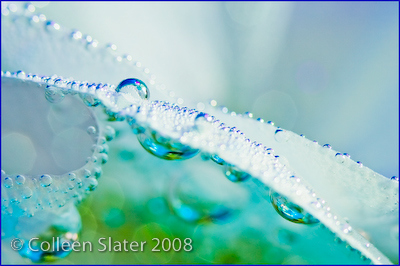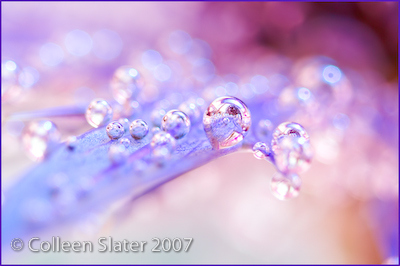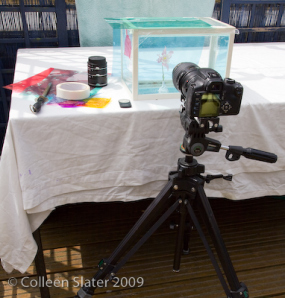Technique Behind the image DIGITAL AND FILM
How was it shot?
Colleen’s kit
EOS 350D
EF 100mm f2.8 Macro lens
Various Extension tubes
Focusing rail
Captivated by the close up world of macro photography, Colleen Slater specialises in photographing flowers submerged underwater, creating colourful contemporary images.
I WAS inspired to take these photos after seeing a panel of photographs that had been submitted to the Royal Photographic Society. I was already interested in macro photography and, after the frustrations of chasing insects around the garden, the idea of a set-up that I would have some control over appealed to me. I find it totally absorbing peering at life anew through a macro lens and am fascinated by the other-worldly look of flowers submerged in water. I aim to convey this in abstract images that have something special in terms of colour and form.
I use an EOS 350D with an EF 100mm f2.8 Macro lens and various extension tubes, ranging from 13mm to 31mm, and a basic focusing rail. I put the flowers in a small fish tank filled with water. I use £1 coins as weights to keep the flowers submerged, wrapping blue tack around the coins and the stem. I put the tank on a white sheet to reflect light onto the flower. I use coloured materials and gels (including sweet wrappers) on the top and sides of the tank to act as coloured filters, creating different colour effects as sunlight shines through them onto the petals. I work outdoors using bright sunshine to create light effects with real sparkle and brilliance. Oxygen bubbles form on the petals or get trapped between them, but they last a day or two at the most. To focus properly, the glass surface needs to be flat, not curved, and the lens needs to be parallel with the glass. The depth-of-field is very narrow – as little as a few millimetres – so I use manual focusing to control precisely which part of the image is sharp or soft. The use of differential focusing is key to achieving good compositions. I shoot at between f2.4 and f8 as using smaller apertures results in images that are over-complicated, with too many details in focus. Mirror lock-up and a remote switch help to stop camera shake and keep images sharp. A sturdy tripod is essential. Sometimes, I have to wait for things to stop moving after a gust of wind, but I can lessen the disturbance by covering the top of the tank with cling film, which also prevents odd bits of dust and small insects getting inside. I constantly make small adjustments to the position of the camera, raising or lowering the height, adjusting the angle of view, turning the camera through different degrees from landscape to portrait, trying to achieve compositions that I’m happy with. I often find that when I have a reasonable composition, the colour is disappointing, or vice versa. I may move the flower around in the tank, change the position of the gels and rearrange the bubbles by pouring more water into the tank. I like experimenting with different flowers and have found that the least likely candidates, such as chrysanthemums, can provide the best results. I get the most pleasing results with pale- coloured flowers. I’d like to get the whole of an air bubble and what is reflected in it in sharp focus, but that is not possible with such a narrow depth-of-field. I’m hoping to achieve the results I want by using a focusing rail to take a series of images with a slightly different focal point, then combine them using software such as Helicon Focus. •
Colleen’s set-up shows a flower submerged in a fish tank, with coloured gels to hand at the side.
For more of Colleen’s images visit: www.colleenslaterphotography.co.uk




